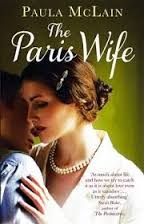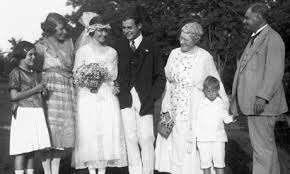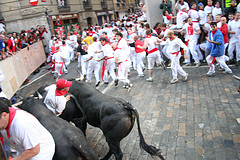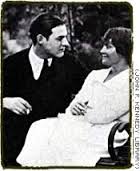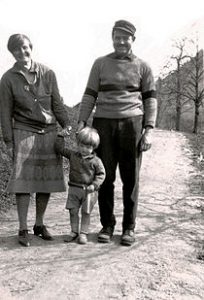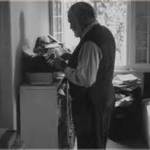I think you will enjoy this. Orson Welles comments on how funny Hemingway was which is unexpected given his books. They are not funny reading. Hope you enjoy this clip.
Author: Christine Whitehead
Mary Welch Wife # 4
As a writer, you should not judge, you should understand. Ernest Heminway
Mary Welch was the only one of Hemingway’s wives who was not from the St. Louis area. She was from Minnesota, was a journalist in her own right, had been married twice and was married to Noel Monks when she met Ernest Hemingway in London. Ernest was still married to Martha but things were not good. Martha often referred to him as “the pig.”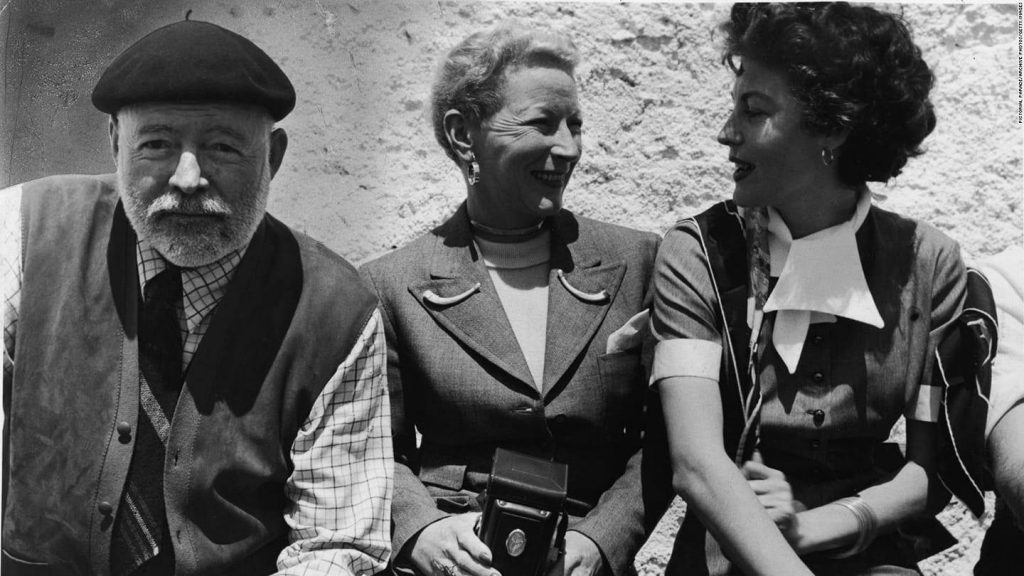
Mary was not tall, about 5’2, stocky, brown hair, and blue eyes. Her features were sharp and she was smart. As usual, the relationship started out well and full of laughs and fun. Hem still could be biting and sarcastically caustic when all was not going well. Mary took it all.
Hem took her to the finca in Cuba, a bit awkwardly since it had been his place with Martha. Gigi was cool to her initially. He loved Martha. Patrick also loved Martha and found it hard to adjust to another new love. However, he liked seeing his father have some order in his life and Mary was nice. Jack, charming and adaptable, found Mary easy company and could fit in well with her without compromising his loyalties to Pauline and Martha as well as to his own mother, Hadley.
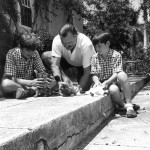
Hem filed for divorce against Martha on grounds of desertion and the divorce went through on December 21, 1945. The sting of her rejection stayed with him always. Martha read about the divorce in the newspaper, although she didn’t care. She was anxious for the divorce to begin and be done. No alimony, no financial orders.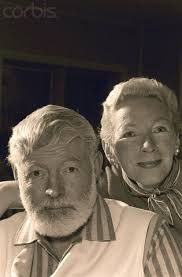
Mary had doubts about marrying Hem. He was . . . not easy. And yet . . . he could be wonderful. Hem, sensing her drift away, sent flowers and love note. They married in Cuba on March 14, 1946. Fights ensued as did a pregnancy at Mary’s age 38, advanced age for 1946. She longed for a daughter for Hem. An ectopic pregnancy with crisis and quick, brave action by Hem ended with Mary surviving, and owing that survival to Hem.

Mary was with him in Ketchum and suffered through Papa’s health declines, his paranoia, his slump and success with The Old Man and the Sea, his rejection, his calling her a scavenger and that she had the face of Torquemada. She suffered through the whole Adriana infatuation. Both however reported an excellent sex life and Hem had earlier complained of Pauline and Martha in that department.

At times, Hem’s drinking increased, then he’d stop for a while on doctor’s orders. Mary was bewildered and badly hurt. However, she wanted to continue to be Mrs. Hemingway for mostly good reasons. She loved his children; she loved him; she loved the position; she was dependent on him financially. Still, she was protective to the end of Hem and his legend.
As Papa became more mentally unstable, Mary did her best. At the end, Hemingway was released from the Mayo Clinic against Mary’s wishes. The day after his release, Hem got up early, got his favorite gun, and shot himself in the head. Mary reported it as an accident while cleaning a gun. It clearly wasn’t. She nurtured the Hemingway legacy as long as she lived and set up the Hemingway collection in the Kennedy Library. She did her best under trying circumstances with little complaint and with dignity.


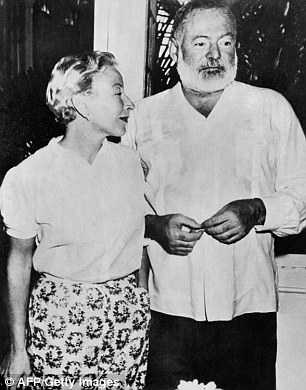
Wife # 3: Martha Gellhorn
“Only one marriage I regret. I remember after I got that marriage license I went across from the license bureau to a bar for a drink. The bartender said, ‘What will you have, sir?’ And I said, ‘A glass of hemlock.’ Ernest Hemingway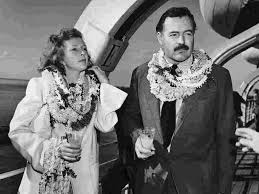
One afternoon in late December as he prepared to leave the cool sawdust interior of Sloppy Joe’s, a trio of tourists walked in. One was a young woman with beautiful hair—tawny gold, loosely brushing her shoulders. She wore a plain black cotton sundress whose simplicity called attention in a well-bred way to her long, shapely legs. Bernice Kurt, The Hemingway women. Page 28.

Martha was lovely, smart, and determined. Born on November 8, 1908, her parents were well educated, a physician and a worker for social causes. Just as Pauline was determined to get Hem from Hadley, Martha knew she needed Hem as her mate. Martha was from St. Louis, just as Hadley and Pauline were. Coincidence but an interesting one. Martha attended Bryn Mawr but left at the end of her junior year. She wanted to be a foreign correspondent and did work in Europe for several years. She returned to the US, became a life-long friend of Eleanor Roosevelt’s. Money was tight but Martha persevered. She wrote a well-received book called the Trouble I’ve Seen, about four age groups who were caught in the cycle of unemployment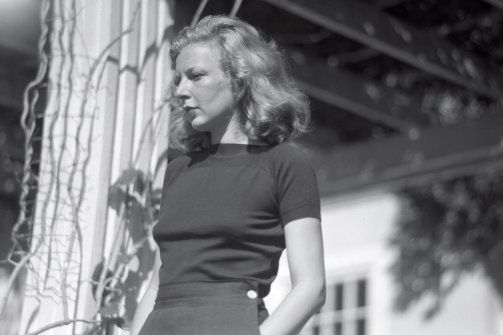
Hem was nine years older than Martha but seemed older. He was a world acclaimed novelist. Compared to Pauline, she was flashy and accomplished. As for her early impressions of Hem, she wrote to Eleanor Roosevelt, “an odd bird, very lovable and full of fire and a marvelous story teller. So I sit about and have just read the mss of his new book and been very smart about it.” Kurt, page 291.

The relationship progressed as they bonded over the Spanish Revolution. Hem was on the fence as to allegiance, in true newsman fashion. Martha was for the Rebels. Both cared deeply about the cause and about Spain. Martha was brave and despite bombings of buildings regularly, both continued their work without complaint. Per Martha, “I think it was the only time in his life when he was not the most important thing there was. He really cared about the Republic and he cared about that war. I believe I never would’ve gotten hooked otherwise.”
As Martha secured her position in Hem’s life, Pauline suffered the loss. With several health issues afflicting her, it became clear that Hem was leaving and there was nothing she could do about it. Hem wrote a letter to Pauline’s mother in 1939 trying to explain the estrangement. Her family had been generous and accepting and it was painful. It also was painful for the boys. “When you were with my father, it was the Crusades. He was Richard the Lion-hearted, and my mother was the woman you left behind in the castle with the chastity belt.” One benefit though was that Patrick and Gigi (Gregory) started to spend summers and vacations with hem which created memories that were irreplaceable. Their half-brother Jack (John/Bumby) had been enjoying those times with his father since the Hadley divorce.

Martha developed a good relationship with the boys. She was loving to all three and they enjoyed her. She had a friendly relationship with Hadley as well.
Hem wrote much of For Whom the Bell Tolls while with Martha. He dedicated it to her. It was selling well and there were bids for the movie rights. He did pay Pauline alimony which he resented as she “didn’t need it.”

Martha found that her husband drank too much, didn’t bathe enough, and embellished his stories. Still she made an effort to be a good hostess, partner, mother, and appreciator of his cats.
As time passed and Martha pursued assignments in China and Europe, Hem felt rejected and their love declined. Hem began to rant and rail against Martha and to heap abuse on her. When they finally divorced, Martha was sad but relieved. No alimony for Martha. She went on to write and establish a successful career in her own right. She married in 1954 and divorced in 1963, living the balance of her life in London. She committed suicide at age 89 with a drug overdose after suffering from cancer and blind.
In a couple weeks, I’ll be giving away three copies of the Hemingway cookbook. It is actually pretty great. There are not only recipes of Hemingway meals but stories and anecdotes related to the novels, stories, and Hem’s life. I really like the cook book. (Details to follow on how to win).
Also, I’d love to have guest posters. If you are the third to guest post, you get one of the cook books. You laugh, but it’s really great. You can write about anything. Review Gellhorn and Hemingway. Talk about his impact on you. Tell us what you hate. did you like Midnight in Paris? Please share!




Did Hemingway Have a Favorite Wife? Hadley
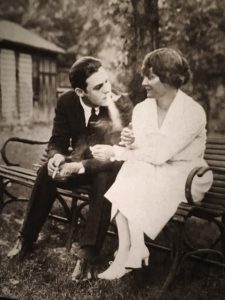
Did Hemingway have a favorite wife? Of course he did despite each wife having suited him at the time he married each.
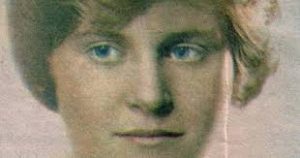
Hemingway had four wives: Hadley Richardson, Pauline Pfeiffer, Martha Gellhorn, and Mary Walsh. Of the four, three were from the St. Louis area. Only Mary was from elsewhere—Minnesota. Hadley was the great love of his life, in my opinion. Surely in retrospect, based on A Moveable Feast, she was.
Hadley and Hem were married on September 3, 1921 in Horton Bay, Michigan, and they spent their honeymoon at the family summer cottage, which featured significantly in Hemingway’s early short stories. Hemingway’s biographer, Jeffrey Meyers, noted in his biography that, “with Hadley, Hemingway achieved everything he had hoped for with Agnes: the love of a beautiful woman, a comfortable income, a life inEurope.” (Agnes was Agnes Von Kurowsky, his nurse in Italy who was the prototype for Catherine Barkley, the heroine of A Farewell to Arms). He called her Tatie or Hash.
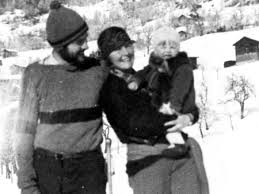
While the Hemingways had little money as they headed to Paris, Hadley’s modest trust fund sustained them. They had a small apartment, as well as a rented studio for Hemingway’s work, plus an abundance of expatriot and European friends, most of whom were writers. Gertrude Stein’s salon was nearby and she was a mentor, although ultimately there was a falling out. 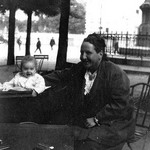
One of the great dramas of their marriage occurred in December, 1922, when Hadley was traveling alone to Geneva to meet Hemingway there (he was covering a peace conference), and Hadley lost a suitcase filled with Hemingway’s manuscripts. One can only speculate about what impact this ultimately had on his writing. At the time, he was devastated. As any writer knows, you can never recreate the first cut. However, scholars opine regularly about whether the loss enabled him to start from scratch and do a better job or whether it was an irreplaceable loss. Clearly, he did okay despite . . .
Still, Hadley was there at the beginning before he was the famous Ernest Hemingway. She was there during the ever-productive Paris years, which proved to be a touchstone gift that kept on giving. She funded his ability to write in Paris, enabling him to eventually at warp speed finish the first draft of The Sun Also Rises in six weeks.
To Hadley’s dismay and hurt, she never figured significantly as a character in any of Hemingway’s books, which did tend to be based on actual people in his life. The fictional memoir, The Paris Wife, paints Hadley as wounded that she was written out of The Sun Also Rises while starring Lady Brett Ashley, who’s based whole hog on Lady Duff Twysden.
Hadley settled into married life as a wife and mother, but trouble was not far away. She and Hem met the charming Pfeiffer sisters. Although initially Hemingway thought Jinny was the more attractive, it was the petite Pauline, a writer for Paris Vogue, who ultimately captured his attention. As Pauline played the role of loyal, jokey pal to both Ernest and Hadley, she set her cap for Hem and he fell hard.
Now it was Hadley’s turn to be devastated. Initially, she resisted a divorce but later agreed. Their son, John aka Jack aka Bumby, was about 4 years old at the time. Hadley graciously accepted Hemingway’s offers of the royalties fromThe Sun Also Rises as child support and alimony. At the time, she had no way of knowing whether those would amount to anything. As of that date, Hemingway’s writings had not created much money at all so for all Hadley knew, this new style of novel might do little in the way of sales.
Of course, the rest was history. Hadley and Hemingway divorced in January of 1927. The Sun Also Rises was published shortly before the final formal divorce. Hemingway married Pauline Pfeiffer in May of 1927. When The Sun Also Rises was made into a film, profits from the film also went to Hadley. 
Hadley and Hemingway remained friendly throughout their lives.She and Hem didn’t socialize, but they were in touch regarding their son, Jack, who was known in the family as Bumby).
Hadley stayed on in France until 1934. Paul Mowrer was a foreign journalist for the Chicago Daily News. She’d known him since the spring of 1927. Mowrer was no light weight himself, having received the Pulitzer Prize as a foreign correspondent in 1929. Hadley and Paul married in London in 1933. The Mowrers ultimately moved to a suburb of Chicago.
After the divorce from Hemingway, Hadley saw Ernest only once again although they wrote to each other regularly. She and Paul Mowrer ran into him while vacationing inWyoming in Sept 1939. Hadley died on January 22, 1979 in Lakeland,Florida. She is the grandmother of Mariel and Margaux Hemingway, who are the children of Jack/Bumby.
Did Hem have a favorite wife? Hell, yes. Her name was Hadley.
http://www.guardian.co.uk/books/2011/mar/10/hadley-freeman-richardson-ernest-hemingway
Tom Maschler, helped Mary with A Moveble Feast. (Some photos added by me.) Aside from the Hemingway connection, he had quite a life.
British publisher Tom Maschler, who conceived the coveted Booker Prize, dies at 87
His crowning achievement arguably came in 1969, when he persuaded sugar trading firm Booker-McConnell to establish a literary prize to rival the French Prix Goncourt. The award, given annually, was later called the Man Booker Prize and is now known as the Booker Prize.The New York Times October 24, 2020 10:58:10 IST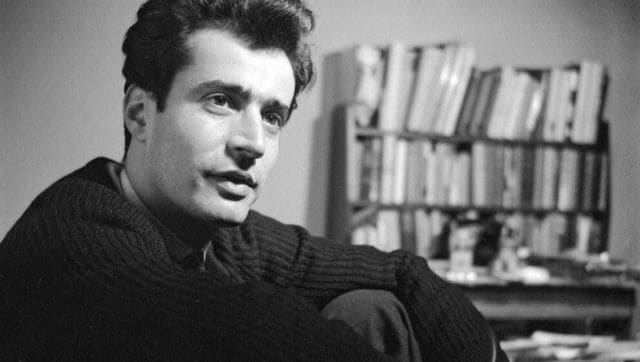
At 26, Tom Maschler was made literary director of Jonathan Cape and catapulted to fame when he acquired the British rights to Joseph Heller’s Catch-22. Image via Twitter
By Sam Roberts
Tom Maschler, the swashbuckling British publisher who fostered the literary careers of more than a dozen Nobel laureates and conceived the coveted Booker Prize to promote fiction, died on 15 October in a hospital near his home in Luberon, in southeastern France. He was 87.
A Jewish refugee from Nazi-occupied Vienna, where his father was a publisher, Maschler was 26 in 1960 when he was named literary director of Jonathan Cape, the prominent London publishing firm, a month after the death of its founder.
He catapulted to early fame by buying the British rights to Joseph Heller’s debut novel, Catch-22, for a bargain 250 pounds in 1961 (the equivalent of about $700 then and about $6,500 today), and, the next year, by transplanting himself to Idaho shortly after the suicide of Ernest Hemingway to help Hemingway’s widow, Mary, prepare the novelist’s memoir A Moveable Feast for publication.

He also published or nurtured Martin Amis, Jeffrey Archer, Julian Barnes, Bruce Chatwin, Roald Dahl, John Fowles, Clive James, Ian McEwan, Edna O’Brien, Thomas Pynchon, Philip Roth and Kurt Vonnegut.
Neither he nor his critics considered him a scholar. He was rejected by the University of Oxford when he applied as an English major. He admitted to being a labored writer. His memoir, Publisher (2005), was widely mocked by reviewers, including one who concluded that it established Maschler’s mantra as “When in doubt, claim credit.”
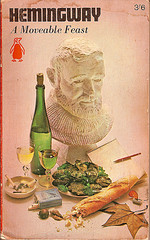
But no one disputed that the splashy Maschler, who had lived largely by his own wits since he was 12, had jolted the clubby British publishing world with his discerning eye for fiction and his Barnumesque promotional ingenuity.
He acquired a collection of writings and doodles by John Lennon and published them in two volumes, In His Own Write in 1964 and A Spaniard in the Works in 1965. In 1983 he published one of the first pop-up books, The Human Body, by Jonathan Miller.
He decided to publish an early manuscript attributed to an author named Virginia Stephen, before he was informed that it was the maiden name of Virginia Woolf.
And after overhearing Desmond Morris, a zoologist, drop the phrase at a cocktail party, he commissioned Morris to write The Naked Ape (1967), a biological perspective on human behavior that became a bestseller. He later recalled counseling Morris, “If you turn this into a book, it’ll be so successful you’ll never again be taken seriously by scientists, but you’ll be very rich.”
His crowning achievement arguably came in 1969, when he persuaded sugar trading firm Booker-McConnell to establish a literary prize to rival the French Prix Goncourt. The award, given annually, was later called the Man Booker Prize and is now known as the Booker Prize.
“The Booker may be the most important thing I’ve ever done,” Maschler told The Guardian in 2005. “It certainly had an impact, and if it means people think they should occasionally read a good novel, that is something I’m very proud of.”
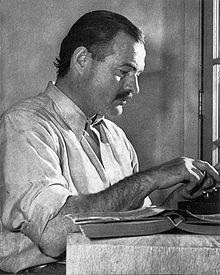
Thomas Michael Maschler was born on 16 August, 1933, in Berlin to Kurt Maschler, a successful publisher’s representative who later became a publisher himself, and Rita (Lechner) Maschler.
Failing to gain passage to Sweden, where they had hoped to proceed to America, Tom and his mother moved to Britain. (His parents had separated by then.) His mother took a housekeeping job on a country estate while he attended a Quaker school.
When he was 12, he was sent to Brittany to learn French. Shortly after that he won a summer scholarship to a kibbutz in Israel, which he was able to reach only after he had audaciously written David Ben Gurion, the Israeli prime minister, asking him to intercede on his behalf.
Maschler was admitted to Oxford to study philosophy, politics and economics (but not English). He rejected the offer after he learned that he had been accepted because of his prowess at tennis.
Instead he traveled to the United States, where he worked in a tuna cannery, was detained for hitchhiking and wrote travel articles for the Los Angeles Times and The New York Times (for which in 1952, at the age of 19, he chronicled a sojourn that had begun when he arrived in New York that year with $13).
He returned to Europe and, after succeeding as a tour guide in Britain and failing as a film director in Italy, entered publishing in 1955 as a production assistant at André Deutsch. He moved to MacGibbon & Kee, to Penguin and finally to Cape, where he was chair from 1970 until the company was bought by Random House in 1991.
Maschler’s survivors include his wife, Regina (Kulinicz) Maschler, whom he married in 1988; three children, Ben, Hannah and Alice, from his first marriage, to Fay Coventry; and several grandchildren.
Maschler, who hopscotched between homes in London, Wales, France and Mexico, was “more admired than liked,” as The Guardian put it. Publisher Patrick Janson-Smith called him “a tainted genius with the gift of being a stranger to self-doubt.”
Asked by The Japan Times in 2008 whether he believed in himself, Maschler replied: “Yes, I believe in myself. I am not necessarily better than other people, but I know I am different from other people. Correct?”
“Yes, yes,” his press agent replied obligingly.
“Actually,” Maschler added with a laugh, “I think I am better as well.”
Sam Roberts c.2020 The New York Times Company
Updated Date: October 24, 2020 10:58:10 IST
TAGS:
Some Hemingway Trivia for the Day
For this post, I present some trivia that people might not know about Hemingway.
- He often wrote standing up especially after the two plane crashes made long bouts of sitting uncomfortable.
- His father committed suicide. His first wife’s father committed suicide. Two of his siblings committed suicide. His former wife, Martha Gelhorn, committed suicide. His Italian muse, Adriana Ivancich, committed suicide. And, of course, Hemingway committed suicide in 1961.
- Contrary to popular myth, his favorite drink was not a Mojito, but a very dry, very cold Martini.
- He originally grew the beard to hide a recurrent skin condition and it became his signature look.
- He never went to college.
- He had an amazing wit and sense of humor, which is not evident in his novels. Read his letters.
- He had little interest in his sartorial presentation. He preferred loose slacks or shorts and wore them to rags.
- His pets were part of his family and he worried about them tremendously when he was away from home. The death of a stray who became his constant companion, Black Dog, threw him into a severe depression. He never got over that death.
10. He always wanted a daughter. His fourth wife Mary became pregnant and a girl was expected, but it was an ectopic pregnancy and was lost. Hemingway had three sons—Jack, the oldest, with his first wife Hadley, and Gregory and Patrick with his second wife Pauline.
Favorite Lines: What are yours? A few of mine. This is part one. at some point there will be a part two.
happy end of dog days of summer!
GREAT LINES FROM HEMINGWAY
1.) You are all a lost generation. The Sun Also Rises.
2.) They’re only dangerous when they’re alone, or only two or three of them together. Chapter 13 – The Sun Also Rises.
3.) Isn’t it pretty to think so? Last line of The Sun also Rises.
4.) Enjoying living was learning to get your monies worth and knowing when you had it. Chapter 14 – The Sun Also Rises.
5.) You know it makes one feel rather good deciding not to be a bitch. Chapter 19 – The Sun Also Rises.
6.) Maybe..you’ll fall in love with me all over again. A Farewell to Arms.
7.) The world breaks everyone and afterward many are strong at the broker places. A Farewell to Arms.
8.) But life isn’t hard to manage when you’ve nothing to lose. A Farewell to Arms.
9.) No, that is a great fallacy. The wisdom of old men. They do not grow wise, they grow careful. A Farewell to Arms.
10.) You won’t do our things with another girl, or say the same things, will you? A Farewell to Arms.
Interview with Hem in Spanish after Nobel Prize
This is interesting . It’s in Spanish and you can tell that Hemingway was enunciating carefully and considering his answers. It seems that he really tried to be gracious about his fans although he was not thrilled with the publicity after the Nobel and Pulitzer Prizes.
http://www.openculture.com/2013/04/ernest_hemingway_appears_on_cuban_tv_in_1954.html
Hemingway and Flannery O’Connor
My Friend, Don, sent on this article. I am not reproducing below only because it is a long one but am sending the link. I enjoyed it and found the parallels and comments on religion, violence, lifestyle to be very interesting. Hope you do too! Waiting for power to go on in Connecticut! Best to all, Christine
“Ernest Hemingway’s published works littered with errors, study says.” Really? This study queries where was the editor. Um, Max Perkins was the editor and what do you all think?
Ernest Hemingway’s published works littered with errors – study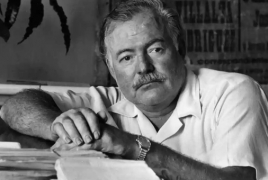 August 3, 2020 – 18:10 AMTPanARMENIAN.Net – Legendary writer Ernest Hemingway’s published writings are riddled with hundreds of errors and little has been done to correct them, The Guardian reports citing a forthcoming study of his texts.Robert W Trogdon, a leading scholar of 20th-century American literature, said Hemingway’s novels and short stories were crying out for editions that are “as accurate to what he wrote as possible” because the number of mistakes “ranges in the hundreds”. Although many are slight, he said, they were nevertheless mistakes, made primarily by editors and typesetters.The majority of Hemingway’s manuscripts are held at the John F Kennedy Presidential Library and Museum in Boston, where Trogdon has pored over the originals.He singled out, for example, the 1933 short story A Way You’ll Never Be, which mistakenly features the word “bat” rather than “hat” when the character Nick Adams is explaining catching grasshoppers to the confused Italian soldiers. Hemingway originally wrote: “But I must insist that you will never gather a sufficient supply of these insects for a day’s fishing by pursuing them with your hands or trying to hit them with a hat.”Misspellings in one edition of “The Sun Also Rises”, his 1926 novel about disillusioned expatriates in postwar France and Spain, include the bullfighter “Marcial Lalanda” appearing as “Marcial Salanda”, an easy mistake to make because of the similarity of the author’s handwritten “L” and “S”, Trogdon observed. There is also a restaurant called “Ciqoque” when Hemingway meant the real-life Paris eatery Cigogne, again an easy mistake for someone unaccustomed to distinguishing the author’s “q” and “g”. August 3, 2020 – 18:10 AMTPanARMENIAN.Net – Legendary writer Ernest Hemingway’s published writings are riddled with hundreds of errors and little has been done to correct them, The Guardian reports citing a forthcoming study of his texts.Robert W Trogdon, a leading scholar of 20th-century American literature, said Hemingway’s novels and short stories were crying out for editions that are “as accurate to what he wrote as possible” because the number of mistakes “ranges in the hundreds”. Although many are slight, he said, they were nevertheless mistakes, made primarily by editors and typesetters.The majority of Hemingway’s manuscripts are held at the John F Kennedy Presidential Library and Museum in Boston, where Trogdon has pored over the originals.He singled out, for example, the 1933 short story A Way You’ll Never Be, which mistakenly features the word “bat” rather than “hat” when the character Nick Adams is explaining catching grasshoppers to the confused Italian soldiers. Hemingway originally wrote: “But I must insist that you will never gather a sufficient supply of these insects for a day’s fishing by pursuing them with your hands or trying to hit them with a hat.”Misspellings in one edition of “The Sun Also Rises”, his 1926 novel about disillusioned expatriates in postwar France and Spain, include the bullfighter “Marcial Lalanda” appearing as “Marcial Salanda”, an easy mistake to make because of the similarity of the author’s handwritten “L” and “S”, Trogdon observed. There is also a restaurant called “Ciqoque” when Hemingway meant the real-life Paris eatery Cigogne, again an easy mistake for someone unaccustomed to distinguishing the author’s “q” and “g”. |


